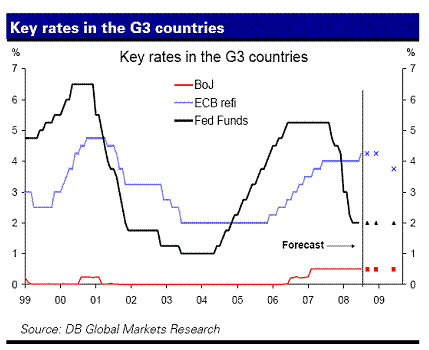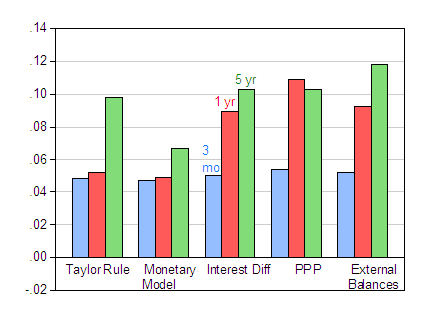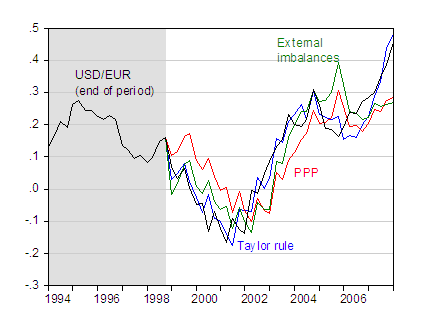As Europe teeters on the edge of recession [0], and the United States remains mired in slow growth, expectations of what interest rates, and hence exchange rates, are shifting. Here’s a familiar depiction of where policy rates in the US and the euro area have been, and where they are predicted to go.

Figure 1: Policy rates and predictions. Source: Deutsche Bundesbank, Global Economic Perspectives July 21, 2008.
As long the euro area rate is projected to be above, and rising relative to, the US interest rate, the euro should remain strong against the dollar. These expectations are popularly thought to be a function of output and inflation gaps. This suggests that output and inflation gaps usefully be thought of as fundamentals for exchange rates. In other words, Taylor rule fundamentals can be used as empirical determinants of exchange rates. [1]
A number of economists have already taken up this approach including Engel and West (2006), papers by Papell et al., and Rogoff and Stavrakeva (2008). They have studied the in-sample and out-of-sample predictions of these Tayor rule fundamentals models. Currently I’m working on a paper examining how the predictability varies with different measures of output gaps, with a focus on the dollar/euro rate, following the spirit of Molodtsova et al. (2008), but focusing on the in-sample characteristics.
As noted in a previous post on output gaps [2], there are number of ways to measure the output gap. I will focus on the output gap measured as a deviation from a quadratic trend applied to real GDP data. I will assume the Taylor rule incorporates an output gap, and inflation gap, a real exchange rate gap where the interest rate responds nonlinearly with respect to the exchange rate gap. This leads to a specification for the four quarter change in the exchange rate of the following form:
st-st-4 = 0.114 – 7.072 ogt-4 – 4.790 pit-4 + 0.313 qt-4 – 9.982 (q3)t-4 + 1.381 it-5 + ut
where adj.R2 = 0.89, SER = 0.052, sample 1999q1-08q1; bold face indicates significance at the 10% level.
In Figure 2, I present the standard error of regression (SER) statistics for the Taylor rule fundamentals regressions at 1, 4, and 20 quarters horizons, and compare them against the corresponding SERs for a sticky-price monetary model error correction model, interest rate differential regressions, purchasing power parity, and an external imbalances model a la Gourinchas-Rey (2007).

Figure 2: Standard error of regression (SER) statistics for five models and for three horizons. Source: Author’s calculations.
What is true is no model fits well for 1 quarter changes in exchange rates, and none do particularly well for 5 year changes. Interestingly, at the 1 year horizon, the Taylor rule fundamentals do as good a job as the monetary model ECM.
In Figures 3 and 4, I present the in-sample predictions of the five models at the one year horizon.

Figure 3: Log dollar/euro rate (black), in-sample 4 quarter ahead prediction from Taylor rule fundamentals (blue), monetary model (red), interest differentials (green). Source: author’s calculations.

Figure 4: Log dollar/euro rate (black), in-sample 4 quarter ahead prediction from Taylor rule (blue), PPP (red) and external imbalances model (green). Source: author’s calculations.
What these graphs make clear is that the Taylor rule does about as well as the monetary model, and noticeably better than the other models. What makes the Taylor rule fundamentals model preferable to the monetary model is the fact that most of the key parameters in the monetary model regressions (money, income, sometimes inflation) have the wrong sign.
Update: The entire paper is here
Armed with these results, I forecast out the one year ahead dollar/euro exchange rate, based upon 2008q1 data. This prediction is presented in Figure 5, along with the plus/minus 2 standard error bands (note that the sample ends in 2008q1, so one year ahead is 2009q1). I also include the Deutsche Bank forecast for end of July 2009.

Figure 5: Dollar/euro rate (blue), dollar/euro rate for 6/30 (blue square), in-sample 4 quarter ahead prediction from Taylor rule fundamentals estimated over 1999q1-08q1 (solid blue square) and associated +/- 2 standard errors (teal +), and DB forecast for 7/09 (red square). Source: author’s calculations and Deutsche Bank Exchange Rate Perspectives, July 24, 2008.
What the figure illustrates is that a sharp reversal in the dollar/euro rate is predicted by the model. Some component of this is being driven by the nonlinearity in the PPP relationship. In the absence of this nonlinearity, the dollar would be predicted to continue to depreciate, largely because of the large negative output gap differential (nearly 3 ppts in 2008q1).
Would I ever bet on this prediction? The answer is no. First, I never put any money in the forex market. Second, despite the success of the equation on statistical grounds, the standard errors are still quite large. Third, there is a complication arising from the fact that in this analysis I have used a mixture of final data (the data older than a year) and final data that has not been through the annual benchmark revision, for the US. Presumably, a similar caveat applies to the euro area GDP data. And it is unclear whether the relationships that obtain for data post-revisions obtain for, say, the 2008Q1 data. For that, the analysis of Molodtsova et al. (2008), which uses real time data, might shed more light (although they too encounter the issue of how to use pre-EMU data).
And of course, these types of macro models are “business as usual” models — they do not address what would happen if there were a large scale shift out of dollar assets by central banks and sovereign wealth funds due to depegging or some other discrete event.[3]
[Update 17 August] An example of the application of a Taylor-rule based exchange rate forecasting procedure is provided by Mike Rosenberg of Bloomberg. I’ve posted his analysis here.
I believe that the Taylor rule should be modeled as a nonlinear relationship. Also, there is empirical evidence for long swings in exchange rate fluctuations which would suggest something like chaotic dynamics.
As for Professor Chinn’s last point, perhaps fiscal policy changes might be a better way for emerging economies to address current account imbalances than currency appreciation.
Menzie –
“And of course, these types of macro models are “business as usual” models — they do not address what would happen if there were a large scale shift out of dollar assets by central banks and sovereign wealth funds due to depegging or some other discrete event.”
Which is just what some Asian CB’s did – sold dollars and bought yen when they were 80 to the dollar (a ridiculous value at the time, but not today). Some currency episodes just beg for prudent currency market speculation. The value of the dollar before the Plaza accord is another example. I think you should consider dabbling a bit with a small margin account. I think you would find it profitable.
“… some other discrete event.”
Well, the Summer Games will come and be gone next month.
I have long thought that the PRC would then pull the plug on its troublesome counterparty (us) at that point in time.
We do not have long to wait to find out.
Regarding the last point I made, according to this brief piece by Gordon Chang, China’s debt-to-GDP ratio might actually be greater than 120%:
http://online.barrons.com/article/SB121642068083866453.html
In my opinion, it is impossible to tell if Mr. Chang is correct or not because the official data from China is notoriously unreliable, but if Mr. Chang is correct then it would limit the amount of fiscal stimulus that the Chinese government might be hoping to provide.
Charlie Stromeyer wrote:
As for Professor Chinn’s last point, perhaps fiscal policy changes might be a better way for emerging economies to address current account imbalances than currency appreciation.
Charlie, you said a lot with few words, but lest it be missed let me add too many words of my own.
If you want to understand how futile demand side economic theories of the Keynesians and monetarists compare Euroland with China. The Chinese are not attempting to strengthen their currency by monetary manipulation. What they attempted to do was peg to the dollar, but the US complained because Chinese growth, fiscal policy, was so effective that the currency was strengthening on its own and the US was losing the competitive edge. The US forced yuan appreciation.
Now shift to Euroland. The Euro is stong because the dollar is weak. Euroland’s solution is monetary manipulation but all it is doing is moving the economy of Europe toward recession. Monetary manipulation cannot overcome bad fiscal policy.
Watch the contrast, and watch how fiscal policy that moves toward free markets and the supply side (China) blows the Keynesian and monetarist demand side (Euroland) out of the water.
DickF, this piece in the Economist shows that the main driver of the Chinese economy is actually investment and that exports are really a rather small part of the Chinese economy:
http://www.economist.com/finance/displaystory.cfm?story_id=10429271
I suppose this means that appreciation of the yuan would have even less of an effect on the current account imbalances. Perhaps Chinese fiscal policy might increase consumption but how could this be done without increasing taxes on savings?
Never put money in the forex market? Not even hedging dollar exposure?
Charlie,
Good article! I am a little skeptical when number are “adjusted” so I believe that China is a little more dependent on exports than the article would lead us to believe but I do believe that China is becoming stronger domestically and now that it has the ability to produce for the domestic market it could sustain a recession in the US and Europe better than most believe.
Mundell has advised the Chinese to concentrate on increasing domestic production and consumption. Initially it appeared that the government might not take his advice but with a growing economy domestic growth will grow naturally. The key is allowing the free market to direct production to satisfy consumption rather than the government directing production and this requires the realization of profits. Something both China and the US congress needs to learn.
DickF, as usual you are correct and I agree with you. I just found this letter about Chinese trade adjustments by Zhi Wang which shows that you are correct about the numbers being “adjusted” because the original study forgot to factor in intermediate inputs in Chinese exports:
http://www.economist.com/opinion/displaystory.cfm?story_id=10559653
DickF, thanks for being skeptical!
Disclosure: long the Chinese yuan for about the past two years.
The paper is now posted here.
I’ve posted the Bloomberg implementation of Taylor-rule based fundamentals (by Mike Rosenberg) here.